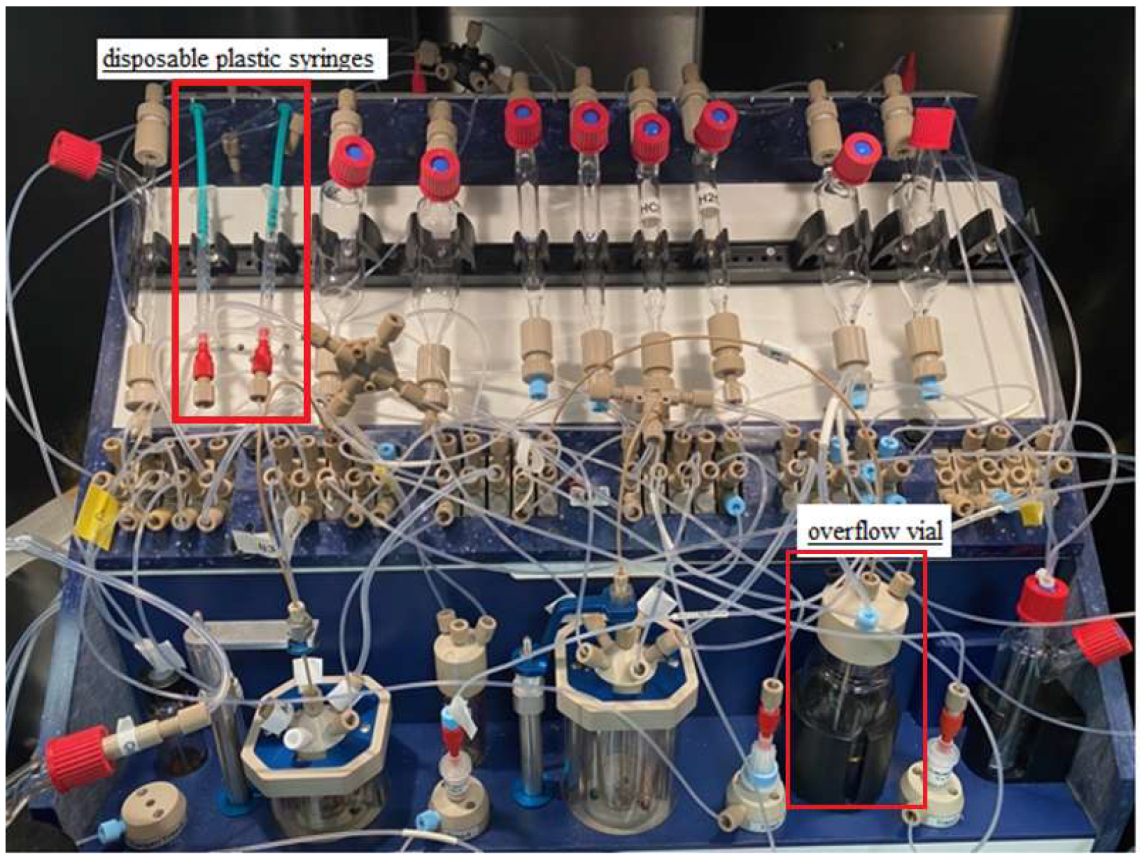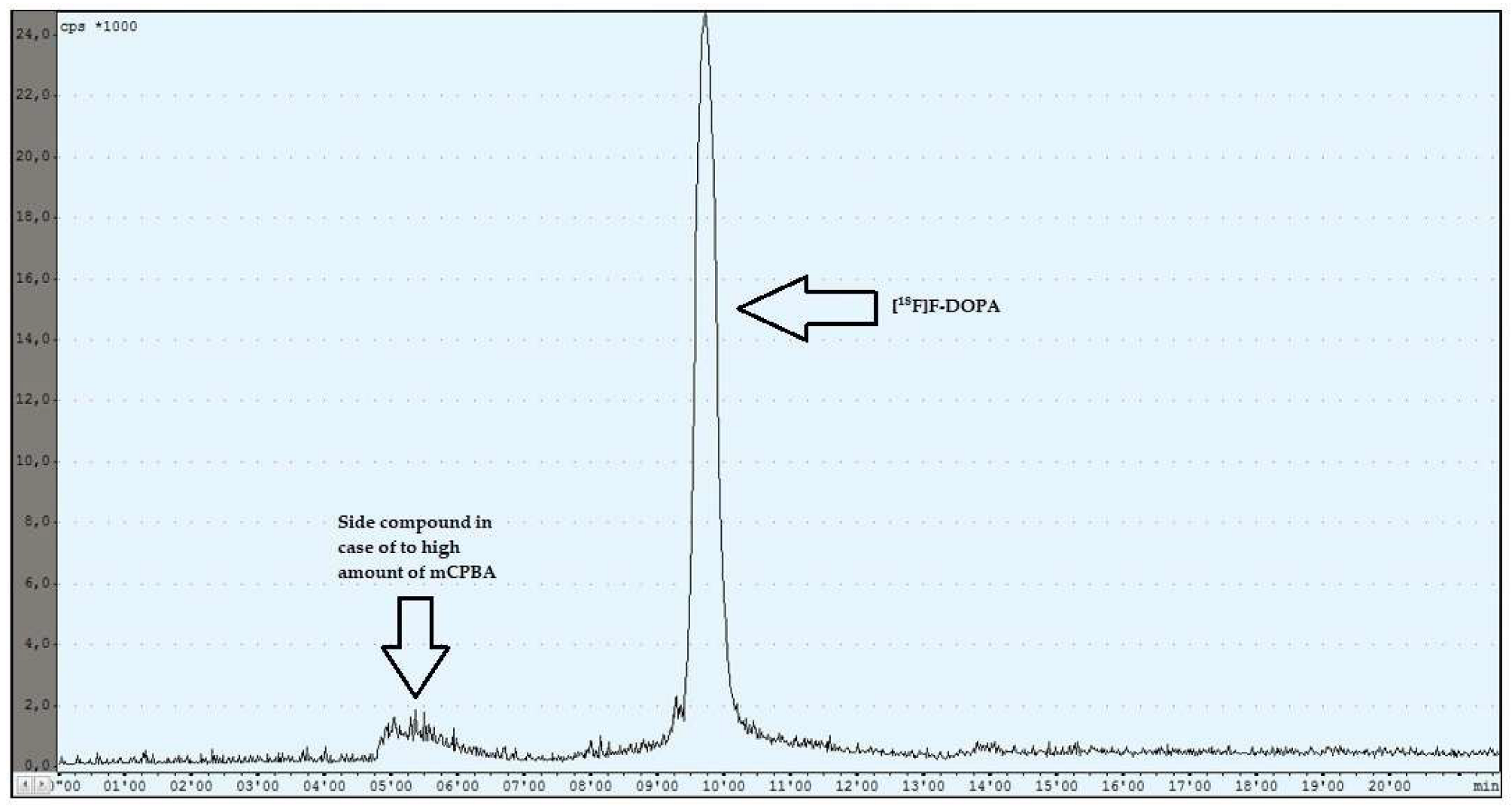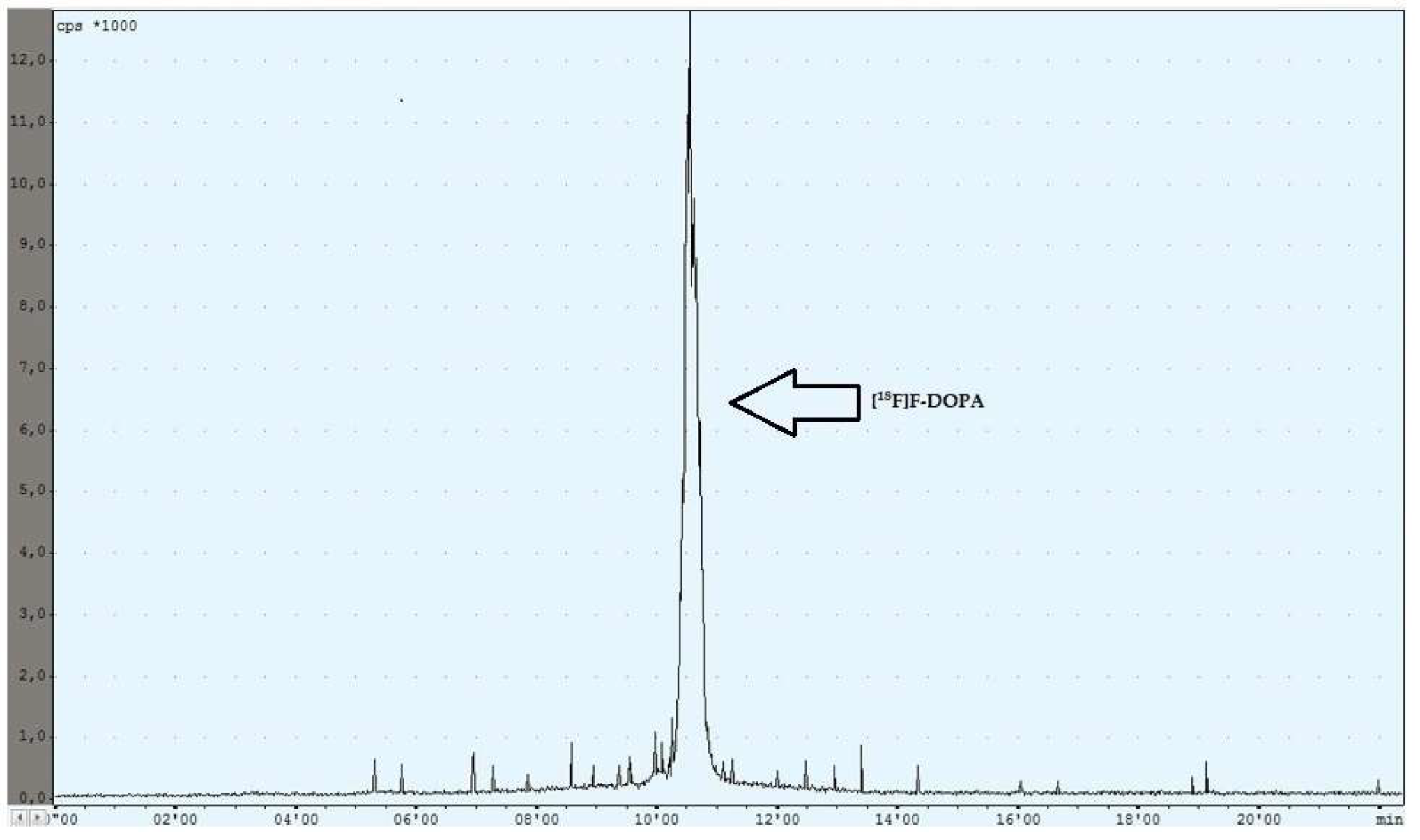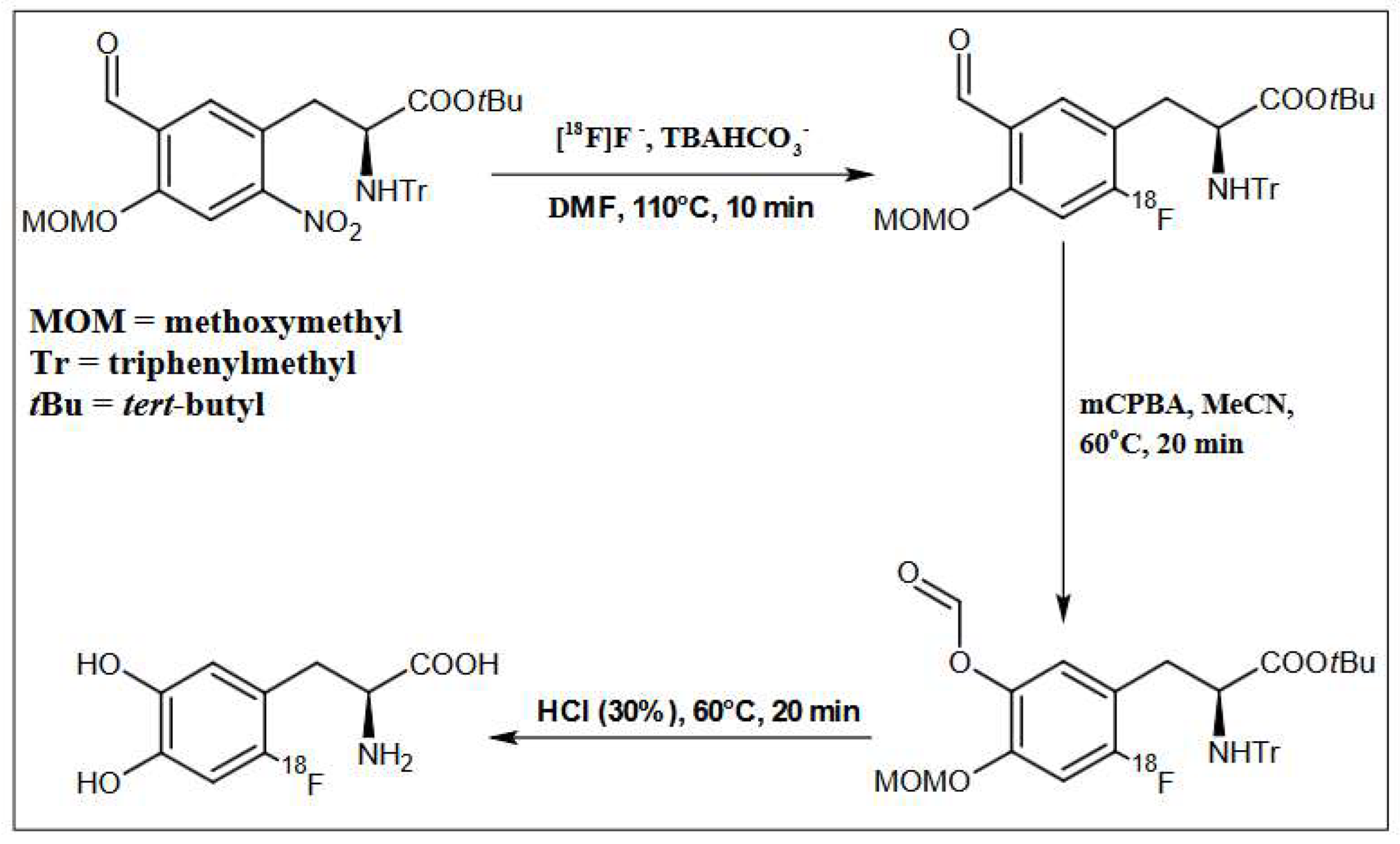Automatic Production of [18F]F-DOPA Using the Raytest SynChrom R&D Module
Abstract
1. Introduction
2. Results and Discussion
2.1. Recovery of the 18F Isotope from the Ion Exchange Column
2.2. 18F Isotope Labeling of the Precursor
2.3. Oxidation Using mCPBA
2.4. Hydrolysis
2.5. [18F]F-DOPA Crude Product Purification
3. Materials and Methods
3.1. General
3.2. Cyclotron Production of the Fluoride Isotope 18F
3.3. Automatic Radiosynthesis Using the Raytest Synchrom R&D Module
3.4. Quality Control
4. Conclusions
Author Contributions
Funding
Institutional Review Board Statement
Informed Consent Statement
Data Availability Statement
Conflicts of Interest
References
- Garnett, E.S.; Firnau, G.; Nahmias, C. Dopamine visualized in the basal ganglia of living man. Nature 1983, 305, 137–138. [Google Scholar] [CrossRef]
- Fischman, A.J. Role of [18F]-dopa-PET imaging in assessing movement disorders. Radiol. Clin. N. Am. 2005, 43, 93–106. [Google Scholar] [CrossRef] [PubMed]
- Darcourt, J.; Schiazza, A.; Sapin, N.; Dufour, M.; Ouvrier, M.J.; Benisvy, D.; Fontana, X.; Koulibaly, P.M. 18F-FDOPA PET for the diagnosis of parkinsonian syndromes. Q. J. Nucl. Med. Mol. Imaging 2014, 58, 355–365. [Google Scholar] [PubMed]
- Groves, A.M.; Win, T.; Haim, S.B.; Ell, P.J. Non-[18F]FDG PET in clinical oncology. Lancet Oncol. 2007, 8, 822–830. [Google Scholar] [CrossRef] [PubMed]
- Seibyl, J.P.; Chen, W.; Silverman, D.H. 3,4-Dihydroxy-6-[18F]fluoro-L-phenylalanine positron emission tomography in patients with central motor disorders and in evaluation of brain and other tumors. Semin. Nucl. Med. 2007, 37, 440–450. [Google Scholar] [CrossRef] [PubMed]
- Jager, P.L.; Chirakal, R.; Marriott, C.J.; Brouwers, A.H.; Koopmans, K.P.; Gulenchyn, K.Y. 6-L-18F-fluorodihydroxyphenylalanine PET in neuroendocrine tumors: Basic aspects and emerging clinical applications. J. Nucl. Med. 2008, 49, 573–586. [Google Scholar] [CrossRef] [PubMed]
- O'Brien, S.R.; States, L.J.; Zhuang, H. Neuroblastoma Shown on 18F-DOPA PET/CT Performed to Evaluate Congenital Hyperinsulinism. Clin. Nucl. Med. 2021, 46, 927–928. [Google Scholar] [CrossRef]
- Piccardo, A.; Lopci, E. Potential role of 18F-DOPA PET in neuroblastoma. Clin. Transl. Imaging 2016, 4, 79–86. [Google Scholar] [CrossRef]
- Fluorodopa (18F) (prepared by electrophilic substitution) injection. Eur. Pharmacopoeia 2008, 6, 990–992.
- Namavari, M.; Bishop, A.; Satyamurthy, N.; Vida, G.; Barrio, J.R. Regioselective radiofluorodestannylation with [18F]F2 and [18F]CH3COOF: A high yield synthesis of [18F]fluoro-L-dopa. Appl. Radiat. Isot. 1992, 43, 989–996. [Google Scholar] [CrossRef]
- Luxen, A.; Guillaume, M.; Melega, W.P.; Pike, V.W.; Solin, O.; Wagner, R. Production of 6-[18F]fluoro-L-dopa and its metabolism in vivo—A critical review. Int. J. Radiat. Appl. Instrum. Part B Nucl. Med. Biol. 1992, 19, 149–158. [Google Scholar] [CrossRef] [PubMed]
- Tredwell, M.; Gouverneur, V. 18F Labeling of Arenes. Angew. Chem. Int. Ed. 2012, 51, 11426–11437. [Google Scholar] [CrossRef] [PubMed]
- Hess, E.; Blessing, G.; Coenen, H.H.; Qaim, S. Improved target system for production of high purity [18F] fluorine via the 18O(p,n)18F reaction. Appl. Radiat. Isot. 2000, 52, 1431–1440. [Google Scholar] [CrossRef] [PubMed]
- Kuik, W.J.; Kema, I.P.; Brouwers, A.H.; Zijlma, R.; Neumann, K.D.; Dierckx, R.A.J.O.; DiMagno, S.G.; Elsinga, P.H. In Vivo Biodistribution of No-Carrier-Added 6-18F-Fluoro-3,4-Dihydroxy-L-Phenylalanine (18F-DOPA), Produced by a New Nucleophilic Substitution Approach, Compared with Carrier-Added 18F-DOPA, Prepared by Conventional Electrophilic Substitution. J. Nucl. Med. 2014, 56, 106–112. [Google Scholar] [CrossRef] [PubMed]
- Libert, L.C.; Franci, X.; Plenevaux, A.R.; Ooi, T.; Maruoka, K.; Luxen, A.J.; Lemaire, C.F. Production at the Curie Level of No-Carrier-Added 6-18F-Fluoro-l-Dopa. J. Nucl. Med. 2013, 54, 1154–1161. [Google Scholar] [CrossRef]
- Wagner, F.M.; Ermert, J.; Coenen, H.H. Three-Step, “One-Pot” Radiosynthesis of 6-Fluoro-3,4-Dihydroxy-L-Phenylalanine by Isotopic Exchange. J. Nucl. Med. 2009, 50, 1724–1729. [Google Scholar] [CrossRef]
- Pretze, M.; Wängler, C.; Wängler, B. 6-[18F]Fluoro-L-DOPA: A Well-Established Neurotracer with Expanding Application Spectrum and Strongly Improved Radiosyntheses. BioMed Res. Int. 2014, 2014, 674063. [Google Scholar] [CrossRef]
- Mele’an, J.C.; Ermert, J.; Coenen, H.H. Enantiospecific synthesis of 2-[18F]fluoro-L-phenylalanine and 2-[18F]fluoro-L-tyrosine by isotopic exchange. Org. Biomol. Chem. 2011, 9, 765–769. [Google Scholar] [CrossRef]
- Pretze, M.; Franck, D.; Kunkel, F.; Foßhag, E.; Wängler, C.; Wängler, B. Evaluation of two nucleophilic syntheses routes for the automated synthesis of 6-[18F]fluoro-l-DOPA. Nucl. Med. Biol. 2017, 45, 35–42. [Google Scholar] [CrossRef]
- Sauvage, C.; Lazarova, N.; Mueller, M. 18F-L-FDOPA Automated Production via the Nucleophilic Route. J. Nucl. Med. 2015, 56 (Suppl. 3), 1011. [Google Scholar]
- Martin, R.; Baumgart, D.; Huebner, S.; Juettler, S.; Saul, S.; Clausnitzer, A.; Mollitor, J.; Smits, R.; Hoepping, A.; Mueller, M. Automated nucleophilic one-pot synthesis of F-18-L-DOPA with high specific activity using the GE TRACERlab MXFDG. J. Label. Compd. Radiopharm. 2013, 56, S126. [Google Scholar]
- Huang, Y.Y.; Poniger, S.; Tsai, C.L.; Tochon-Danguy, H.J.; Ackermann, U.; Yen, R.F. Three-step two-pot automated production of NCA [18F]FDOPA with FlexLab module. Appl. Radiat. Isot. 2020, 158, 108871. [Google Scholar] [CrossRef] [PubMed]
- Martin, R.; Baumgart, D.; Huebner, S.; Juettler, S.; Saul, S.; Clausnitzer, A.; Mollitor, J.; Smits, R.; Hoepping, A.; Mueller, M. First SPE method for routine production of nucleophilic L-[18F]FDOPA. J. Label Compd. Radiopharm. 2013, 56, S126. [Google Scholar]







| Amount of TBAHCO3− (µL) | Amount of MeCN (µL) | Activity Remained on the Column 12 H after the End of the Synthesis (MBq) | Calculated Remaining Activity (MBq) | Total Drying Time after Two Azeotropic Distillations (Min) | Percentage Activity Decrease (%) |
|---|---|---|---|---|---|
| 50 µL | 50 µL | 1.20 MBq | 10,700 MBq | 8 min | 13.4% |
| 100 µL | 100 µL | 0.45 MBq | 4000 MBq | 12 min | 10.4% |
| 150 µL | 150 µL | 0.37 MBq | 3300 MBq | 16 min | 12.1% |
| 200 µL | 200 µL | 0.25 MBq | 2300 MBq | 21 min | 14.1% |
| EOB = 120 GBq, 80 °C, n = 3 | |||||
| Amount of Precursor (mg) | Amount of Solvent (µL) | Time (min) | RCY (%) |
|---|---|---|---|
| 10 mg | 500 µL | 10 min | 70% |
| 30 mg | 1000 µL | 10 min | 10% |
| TBAHCO3−, DMF, 110 °C, n = 3 | |||
| Vial | Syringe | |
|---|---|---|
| RCY (%) | 50% | 65% |
| 20% | 70% | |
| 10% | 67% | |
| 40% | 72% | |
| 15% | 65% | |
| TBAHCO3−, DMF, 10 mg precursor, 110 °C, n = 5 | ||
| Method | Time (min) | Temperature (°C) | Amount of mCPBA (mg) | Solvent | Amount of Precursor (mg) |
|---|---|---|---|---|---|
| Sauvage [20] | 20 min | 60 °C | - | MeCN | - |
| Martin [21] | 16 min | 55 °C | - | MeCN | - |
| Pretze [19] | 20 min | 65 °C | 5 mg | CH3Cl | 7 mg |
| Huang [22] | 9.5/5.5 min | 65/55 °C | 20 mg | MeCN | 30 mg |
| This work | 20 min | 60 °C | 7 mg | MeCN | 10 mg |
| Method | Time (min) | Temperature (°C) |
|---|---|---|
| Sauvage [20] | - | 40 °C |
| Martin [21] | 20 min | 50 °C |
| Pretze [19] | 20 min | 65 °C |
| Huang [22] | 20 min | 50 °C |
| This work | 20 min | 60 °C |
| Vial/Component | Reagent | Volume |
|---|---|---|
| SC1 | 0.075M TBAHCO3− in MeCN | 100 µL + 100 µL |
| SC2 syringe | MeCN | 250 µL |
| SC3 syringe | Precursor (ABX 1336) in DMF | 10 mg + 500 µL |
| SC4 | MeCN/H2O | 4 mL (4:1) |
| OVERFLOW VIAL | MeCN/H2O | 16 mL (4:1) |
| SC5 | H2O | 15 mL |
| SC6 | MeCN | 2 mL |
| SC7 | mCPBA in MeCN | 7 mg + 2 mL |
| SC8 | HCl (30%) + containing 3% EtOH | 1 mL + 30 µL |
| SC9 | H2O | 5 mL |
| Trap 1 | Conditioned QMA | one |
| Trap 2 | Conditioned C18ec | one |
| Semipreparative HPLC | Hamilton PRP 10 μm 250 × 10 mm H2O, flow 4 mL/min | - |
| QC Test | Specification (Acceptance Criteria) | QC Result | ||
|---|---|---|---|---|
| QC 1 | QC 2 | QC 3 | ||
| Appearance | Clear, colorless solution | Comply | Comply | Comply |
| pH | 4.0–5.5 | 4.8 | 5.1 | 5.0 |
| Radionuclidic identification | Gamma photons have an energy of 497–526 keV | 514 keV | 516 keV | 512 keV |
| Half life | 105–115 min | 109.5 | 109 | 110 |
| Radiochemical purity (HPLC) 6-[18F]-DOPA | ≥95% the total radioactivity | 99.6% | 97.6% | 99.4% |
| Radiochemical purity (TLC) 6-[18F]-DOPA | ≥95% the total radioactivity | 97.9% | 96.2% | 95.67% |
| Enantiomeric purity L-form of 6-[18F]-DOPA | ≥96% the total radioactivity | 97.4% | 98.9% | 98.1% |
| Chemical purity (HPLC) All chemical impurities Including total peak of 6-fluoro-L-DOPA | 2.5 mg/5 mL (0.5 mg/mL) | 0.0107 mg/mL | 0.018 mg/mL | 0.4408 mg/mL |
| Residual TBA | <1.3 mg/5 mL (<0.26 mg/mL) | <0.26 mg/mL | <0.26 mg/mL | <0.26 mg/mL |
| Residual solvents: | ||||
| Ethanol (GC) | ≤50 mg/5 mL (≤10 mg/mL) | 1.063 mg/mL | 0.004 mg/mL | 0.2706 mg/mL |
| Acetonitrile (GC) | ≤ 4.1 mg/5 mL (≤ 0.82 mg/mL) | 0.7854 mg/mL | 0.0023 mg/mL | 0.0029 mg/mL |
| Methanol (GC) | ≤30 mg/5 mL (≤6 mg/mL) | 0.8294 mg/mL | 0.0028 mg/mL | 0.0008 mg/mL |
| Bacterial endotoxins | <175 EU/5 mL (<35 EU/mL) | <0.250 EU/mL | <0.250 EU/mL | <0.250 EU/mL |
| Filter integrity test | ≥3 Bar | 4.0 Bar | 4.2 Bar | 4.0 Bar |
| Sterility * | Sterile | Comply | Comply | Comply |
Disclaimer/Publisher’s Note: The statements, opinions and data contained in all publications are solely those of the individual author(s) and contributor(s) and not of MDPI and/or the editor(s). MDPI and/or the editor(s) disclaim responsibility for any injury to people or property resulting from any ideas, methods, instructions or products referred to in the content. |
© 2022 by the authors. Licensee MDPI, Basel, Switzerland. This article is an open access article distributed under the terms and conditions of the Creative Commons Attribution (CC BY) license (https://creativecommons.org/licenses/by/4.0/).
Share and Cite
Waśniowski, P.; Czuczejko, J.; Chuchra, M.; Wędrowski, M.; Marciniak, D.; Sobiak, S.; Małkowski, B. Automatic Production of [18F]F-DOPA Using the Raytest SynChrom R&D Module. Pharmaceuticals 2023, 16, 10. https://doi.org/10.3390/ph16010010
Waśniowski P, Czuczejko J, Chuchra M, Wędrowski M, Marciniak D, Sobiak S, Małkowski B. Automatic Production of [18F]F-DOPA Using the Raytest SynChrom R&D Module. Pharmaceuticals. 2023; 16(1):10. https://doi.org/10.3390/ph16010010
Chicago/Turabian StyleWaśniowski, Paweł, Jolanta Czuczejko, Michał Chuchra, Mateusz Wędrowski, Dawid Marciniak, Stanisław Sobiak, and Bogdan Małkowski. 2023. "Automatic Production of [18F]F-DOPA Using the Raytest SynChrom R&D Module" Pharmaceuticals 16, no. 1: 10. https://doi.org/10.3390/ph16010010
APA StyleWaśniowski, P., Czuczejko, J., Chuchra, M., Wędrowski, M., Marciniak, D., Sobiak, S., & Małkowski, B. (2023). Automatic Production of [18F]F-DOPA Using the Raytest SynChrom R&D Module. Pharmaceuticals, 16(1), 10. https://doi.org/10.3390/ph16010010






